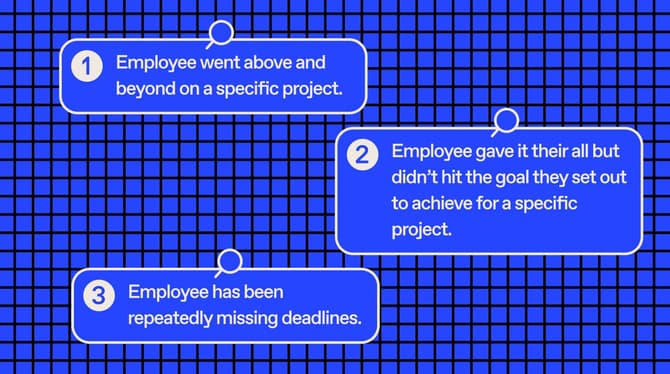As a manager, you always want to lead your team to new heights. In many aspects, management and coaching can be pretty similar. Because of this, managers can benefit from using a coaching approach with their team members. But before you can lead your team to a championship, you have to learn about your players. What are their goals? What are their strengths? Where can they grow? As the great coach Phil Jackson once said:
“The strength of the team is each individual member.”
Just like a coach, you have a roster of different players who probably have very different skill sets. If you want to take your team to the next level, you have to guide your employees to achieve both their individual and collective goals.
Luckily, scientific models like the GROW model exist to help managers like you to coach employees to success. Similar to private coaching sessions, one-on-ones are a great way to build solid relationships with your team members. To effectively coach employees in one-on-one meetings, you need to ask the right questions.
Use the GROW coaching questions from this article to build championship DNA within your team.
Exclusive online summit
·
May 23 2024
Moments that matter: how to seed great work
In this article you will learn:
What is the GROW coaching model?
The GROW coaching model helps managers make one-on-one conversations effective and impactful. By asking the right question at the right time, you can guide your team members to uncover their own solutions, and drive their own development.
The GROW coaching model
- Goals: What are the goals of the conversation?
- Reality: What is the reality or context of the situation?
- Options: What are the options for moving forward?
- What’s next: How do you want to proceed?
Keep this framework in mind when you structure your meeting agenda. Use the GROW coaching questions outlined below to coach employees through these four steps and toward setting action items.
Examples of GROW coaching model questions
Here are questions examples for each category of the GROW coaching model. Feel free to add these to your next one-on-one meeting agenda.
Questions for your team member about goals
Start by making sure you and your team member want the same thing out of the meeting. This can vary depending on a number of factors, so always check-in at the start of the conversation. Employees might need guidance, a sounding board, clarification, or something else. Use these questions to establish a common objective.
- What do we want to get out of this meeting?
- I’ve noticed [issue to address], would you be open to working through this together today?
- What exactly is the issue you’re trying to resolve?
- Why is it important to resolve this situation?
- What’s at stake if we don’t resolve it?
- How would you measure success for this initiative?
- How long do you feel it will take to resolve this issue?
Examples of questions to understand the reality
Once you’ve set your shared intention for the conversation, your employee can fill you in on the details you’ll need to give feedback effectively. To coach your team member correctly, you need to understand their current reality. If someone is struggling to manage their work-life balance, there might be things going on in their personal life that you’re not aware of or you might not have a clear picture of their full workload. Asking open-ended questions, and a few more specific questions when needed, will help you have the right context to work through the situation together.
- What is working well right now?
- What do you think is blocking you?
- Have you already taken any steps towards your goal? Describe what you did.
- If you haven't taken steps yet, how could you act on this issue?
- What is happening now (what, who, when, and how often)? What is the effect or result of this?
- Are you the only person affected by this current situation?
- Are you the only person responsible for solving this issue?
Questions to explore options with your team member
With a solid foundation for understanding, you can begin weighing different options for how to proceed with your team member. For example, if someone is disagreeing with a colleague on how to tackle a problem, you can discuss how they might speak with their coworker directly, or bring in other team members to make it a group decision. The effective questions outlined below will help you explore various approaches to the current situation during your one-on-one meeting.
- What have you already tried? What else could you try? What have you not tried yet?
- What are the usual solutions available to you?
- How would you approach the current situation if you had unlimited time or resources?
- If you could start from scratch, how would you approach the situation differently?
- Which of the options you have do you feel will help you accomplish your goal?
- How could you do things differently?
- How could you simplify the solution even further?
- Who can help you succeed and how?
Questions to decide what’s next
Successful meetings end with establishing next steps and setting action items that you can follow up on in your next one-on-one. It might be tempting to give your team members next steps when you have ideas for them, but coaching means guiding your employees to learn and find the answers on their own. These questions can help you clarify the output of your discussion, so you can both walk away feeling that you’re going in the right direction. You can use them to build an action plan that will help your employee to succeed with their goals.
- If you could do only one thing right now, what would it be?
- Out of all your options, which one do you think is the best choice?
- What do you choose to do in relation to the situation?
- When? Why?
- Do you feel confident with this choice? Why?
- What will be your main challenge?
- What else do you need to succeed?
- What follow-up should be done to ensure you succeed?
Managers need some coaching, too
Managers don't need to have perfect coaching skills to be able to lead their employees to success. By using the GROW framework, you can ask the right questions during your one-on-one meetings to take employee development to the next level, and keep every team member engaged.
Sometimes, it's all it takes to turn a team into a dynasty.



